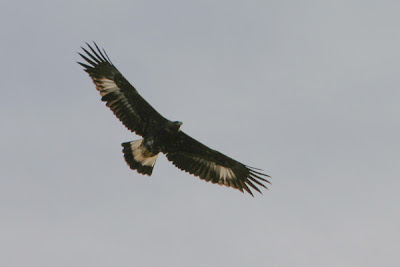Golden Eagle
Short-toed Eagle
Of course, we’ve also visited several of our favourite sites in the Algarve. At Quinta do Lago, we were pleased to get good views of a Purple Heron and a Little Bittern and once again a couple of Sacred Ibises were seen alongside the more familiar Glossy Ibises. At Ludo, we expected to find Booted Eagles and we weren’t disappointed.
Little Bittern
At Castro Marim, we had several encounters with noisy Great Spotted Cuckoos and at Aldeia Nova there was a Common Cuckoo. Last year we sponsored ‘Chris’, one of the Common Cuckoos that the BTO tagged and have been tracking by satellite throughout the winter months. It’s interesting that we have Cuckoos returning here now to the Algarve but ‘Chris’ and the other BTO Cuckoos, that are presumably going to return to the UK, are still in West Africa.
Great Spotted Cuckoo
Yesterday, during the high tide period, we were at Castro Marim again to carry out a count of the waders and other birds, mostly Greater Flamingos and Spoonbills, on the saltpans there. Avocets, Dunlins, Grey Plovers and Ringed Plovers were the most numerous species but the job wasn’t made any easier by a male Montagu’s Harrier that spooked the birds on a couple of occasions. Normally we love to see Montagu’s Harriers but when we’re half way through counting a flock of several hundred birds and they all take off in panic…well that does tend to change our views! It recalled occasions at Belvide Reservoir years ago when a Peregrine Falcon would often be the culprit that disrupted wildfowl counts.
Meanwhile, here in Tavira we’re starting to see a few more migrants. This morning we came across several Woodchat Shrikes, Greater Short-toed Larks and a Subalpine Warbler and heard the familiar calls of Bee-eaters. Our ‘bird of the morning’, however, was probably a lovely Black-necked Grebe in fine summer plumage. We have still been seeing Bluethroats this week but they will soon be on their way north. The Slender-billed Gulls that have wintered here will also soon be leaving; there are currently 14 of them. Only three years ago this species was classified as a rarity in Portugal but in the south-east of the country we go out most of the year almost expecting to see them and maybe it won’t be long before they join Audouin’s Gulls and breed here.
Woodchat Shrike
Bluethroat
Slender-billed Gull
























